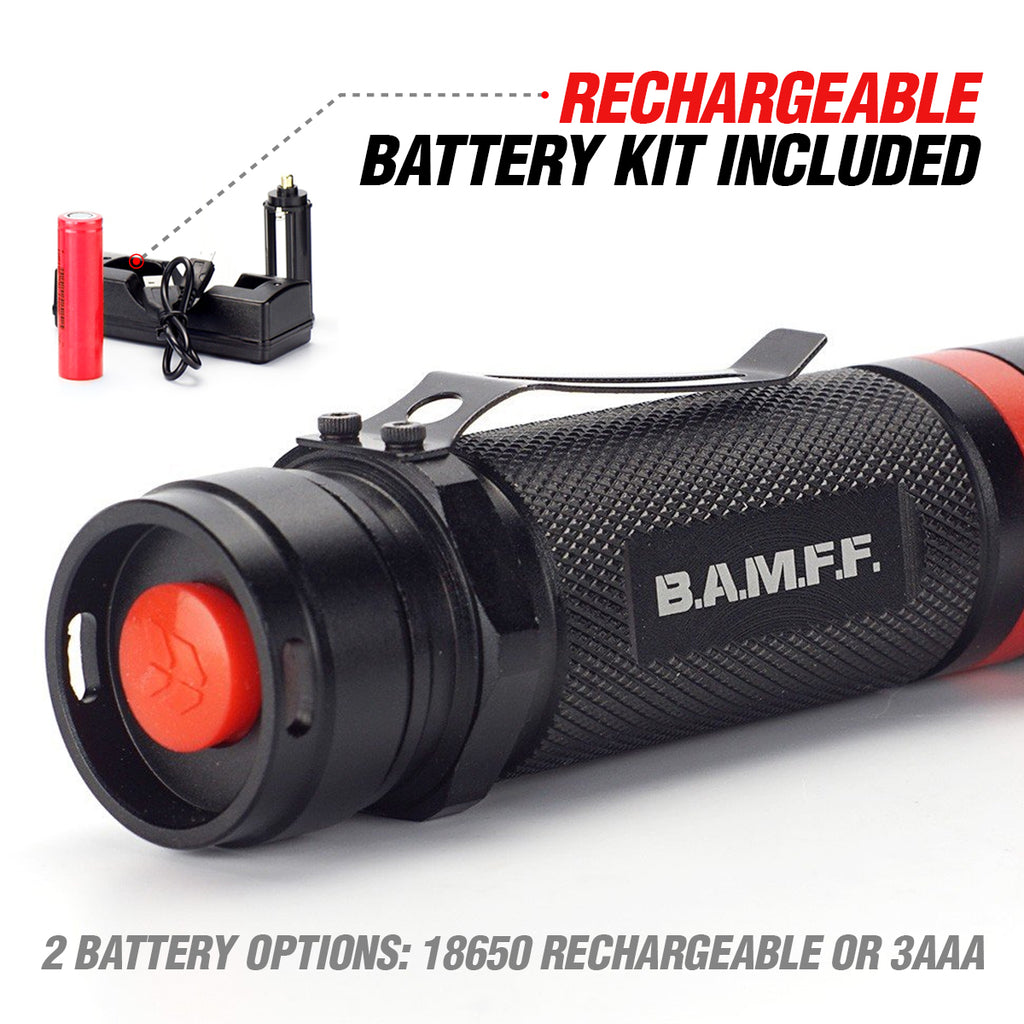
How Long Does A LED Flashlight Last? Bulb & Battery Life
Share
It’s clear to understand that flashlights are a necessity in our everyday lives. Some may need one more than others, but they’re great to have in case of any emergencies. A question that is commonly left unanswered is “how long does a flashlight last”? After developing our own innovative tactical flashlight, the B.A.M.F.F, we’ve gathered data and found out the following.
As a rule of thumb, the lower output of lumens, the longer the LED flashlight will last. Flashlights with an output ranging between 40-400 lumens have 15 hours of runtime at the lower setting (40 lumens) and 2 hours of life in the higher mode (400 lumens). These are approximates and may vary between flashlights, environments, and batteries.
The above estimates are taken from our Dual LED Tactical Flashlight range, the B.A.M.F.F. To get a better understanding of how long our flashlights last, click here to gain access to our technical performance chart.
Runtime is measured 30 seconds after the light is turned on, and then the time it takes for the flashlight to decrease in output by 10%. For example, if a flashlight has 250 lumens, a test will be conducted by leaving the flashlight on until its power output decreases to 225 lumens (10%).
Now you have a basic understanding of how long a LED flashlight will last, let’s discuss the two vital components that enhance this runtime.
How Long Do LED Flashlight Batteries Last?
How long an LED flashlight battery will last can be based on a bunch of different variables. Here are the main factors to consider:
As you’re able to see from the above, there is an abundance of different factors that play an essential role in your flashlight’s battery life. Having a basic understanding of these will ensure you’re able to get the maximum usage out of your batteries and certify a longer runtime for your flashlight.
What Is the Longest Lasting Flashlight?
Although the longest-lasting flashlight hasn’t been determined, we most definitely have some flashlights within our B.A.M.F.F range that’ll blow your expectations. With our Dual LED Tactical Flashlights, we have created a comprehensive range to suit all user’s needs.
At STKR, we understand the practicality and importance of having a broad selection of flashlights to suit our customer’s needs. In the B.A.M.F.F. range, you’ll be greeted with six different flashlights which offer different lumen outputs, runtime, light distance, and intensity.
To gather a better understanding of this versatile range, I recommend looking at this technical performance chart. Here you’re able to see the version of the flashlight, its output, and runtime based on the brightness mode you’ve selected.
We believe information like this needs to be widely accessible to the public. Before purchasing a flashlight, it’s essential to know these basic performance ratings. By establishing this, you can gather a better knowledge of what flashlight suits your specific needs.
For example, if you wanted a flashlight that exceeds most runtimes found in the industry, you’d want to opt-in for the B.A.M.F.F 4.0 XL, as this can last up to 20 hours on the lowest output setting. Whereas customers that want something powerful, you’ll want to select a B.A.M.F.F 10.0 as this can produce 1000 lumens on its highest setting.
Do LED Flashlights Burn Out?
The LED bulb was introduced commercially back in 2002, and it’s been a phenomenon ever since. Although there have been various types of LEDs such as COB and SMD LED, each has provided us with longer-lasting lighting.
LEDs by far have been the most efficient lighting source that has been created. Although LEDs can burn out, it’s relatively uncommon to see it within a lifetime if it’s in perfect condition. Most LED flashlights are evaluated to have a minimum of 50,000 hours of life. Meaning if you use your flashlight for 24 hours a day, you’ll receive over 2,000 days of usage. However, I’m no mind reader, but I can imagine you won’t be using a flashlight for 24 hours a day.
But of course, in some cases, your flashlights LED can encounter a burnout. This is because of the heat the bulb produces. When the heat waste builds up in the neck of the bulb just above the socket, it can reach pretty high temperatures. The electronic components that make up a LED bulb struggle to operate under these extreme environments and might burnout from the heat if not designed to properly dissipate heat.
Keep in mind that a burnout can seem unnoticeable at times. An LED burning out doesn’t mean it’ll stop emitting light but actually dim the light produced. This can partially be hard to notice as humans have difficulty comparing two lights side by side that have a reduced output of 50%.
But luckily, from the technology of the world progressing, purchasing spare LED bulbs is exceptionally cheap. A bulb that’ll last a minimum of 50,000 hours in perfect conditions will probably cost you a few dollars, and maybe not even that.
Conclusion
You should now have a solid understanding of how long an LED flashlight lasts. It’s essential to have a basic knowledge of this, so you can ensure you’re purchasing a suitable flashlight for your needs. Without a doubt, investing in a quality LED flashlight can reinsure you’ll get plenty of usage out of your purchase. LEDs are built to last and will most definitely stay in the industry. They’re inexpensive, provide long-lasting light, and receive much better outputs than traditional bulbs.



